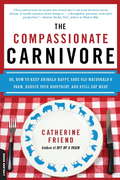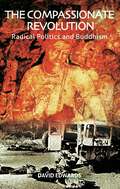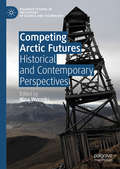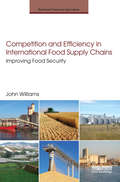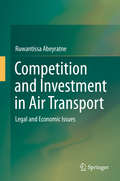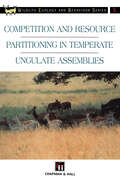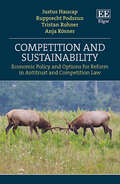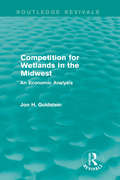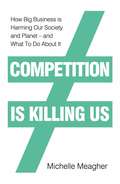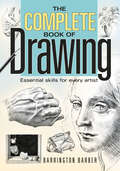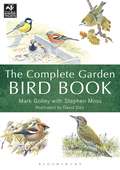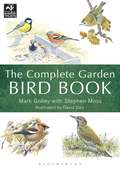- Table View
- List View
Comparisons in Resource Management: Six Notable Programs in Other Countries and Their Possible U.S. Application (RFF Natural Resource Management Set)
by Henry JarrettOriginally presented as public lectures in the 1961 Resources for the Future Forum on Comparative Resources Policy and Administration. Originally published in 1961
Comparisons in Resource Management: Six Notable Programs in Other Countries and Their Possible U.S. Application (RFF Natural Resource Management Set)
by Henry JarrettOriginally presented as public lectures in the 1961 Resources for the Future Forum on Comparative Resources Policy and Administration. Originally published in 1961
The Compassionate Carnivore: Or, How to Keep Animals Happy, Save Old MacDonald's Farm, Reduce Your Hoofprint, and Still Eat Meat
by Catherine FriendCatherine Friend tackles the carnivore's dilemma, exploring the contradictions, nuances, questions, and bewildering choices facing today's more conscious meat-eaters. The Compassionate Carnivore is "perfect for people who would like to eat meat but have moral, ethical, or health concerns about doing so” (Marion Nestle, What to Eat). Based on her own personal struggle, Friend's original, witty take on the meat and livestock debates shows consumers how they can be healthy and humane carnivores, too.
The Compassionate Revolution: Radical Politics and Buddhism
by David EdwardsAn enlightening examination of the ways our capitalist system depends on three corrupt principles: greed, hatred and ignorance.After exploring in Free to be Human the ways the mass media distorts our understanding of many personal, ethical and spiritual issues to make us willing to accept the irrational values of corporate consumerism, political writer David Edwards is back with another powerful read.In The Compassionate Revolution, David builds on his argument, showing how our capitalist system is dependent on the promotion of the three Buddhist Poisons of Greed, Hatred and Ignorance: greed for profit at any cost in terms of human suffering; hatred of foreign obstacles to profit; ignorance of the cosy link between Western corporations and Third World dictators, helping to protect Western profits.Western activists need to recognise the truly revolutionary potential of the Buddhist conviction that compassion is the basis of all happiness. The antidote to exploitative social systems is rational awareness rooted in unconditional kindness and compassion for all. By marrying the political arguments of activists like Noam Chomsky and Howard Zinn with the compassionate awareness of Buddhist writers such as Aryasura, Geshe Gyeltsen and Stephen Batchelor, David shows how we can instigate a compassionate revolution in which the only enemies and casualties are greed, hatred and ignorance.
The Compassionate Revolution: Radical Politics and Buddhism
by David EdwardsAn enlightening examination of the ways our capitalist system depends on three corrupt principles: greed, hatred and ignorance.After exploring in Free to be Human the ways the mass media distorts our understanding of many personal, ethical and spiritual issues to make us willing to accept the irrational values of corporate consumerism, political writer David Edwards is back with another powerful read.In The Compassionate Revolution, David builds on his argument, showing how our capitalist system is dependent on the promotion of the three Buddhist Poisons of Greed, Hatred and Ignorance: greed for profit at any cost in terms of human suffering; hatred of foreign obstacles to profit; ignorance of the cosy link between Western corporations and Third World dictators, helping to protect Western profits.Western activists need to recognise the truly revolutionary potential of the Buddhist conviction that compassion is the basis of all happiness. The antidote to exploitative social systems is rational awareness rooted in unconditional kindness and compassion for all. By marrying the political arguments of activists like Noam Chomsky and Howard Zinn with the compassionate awareness of Buddhist writers such as Aryasura, Geshe Gyeltsen and Stephen Batchelor, David shows how we can instigate a compassionate revolution in which the only enemies and casualties are greed, hatred and ignorance.
Compatible Solutes Engineering for Crop Plants Facing Climate Change
by Shabir Hussain Wani Manu Pratap Gangola Bharathi Raja RamadossPlants, being sessile and autotrophic in nature, must cope with challenging environmental aberrations and therefore have evolved various responsive or defensive mechanisms including stress sensing mechanisms, antioxidant system, signaling pathways, secondary metabolites biosynthesis, and other defensive pathways among which accumulation of osmolytes or osmo-protectants is an important phenomenon. Osmolytes with organic chemical nature termed as compatible solutes are highly soluble compounds with no net charge at physiological pH and nontoxic at higher concentrations to plant cells. Compatible solutes in plants involve compounds like proline, glycine betaine, polyamines, trehalose, raffinose family oligosaccharides, fructans, gamma aminobutyric acid (GABA), and sugar alcohols playing structural, physiological, biochemical, and signaling roles during normal plant growth and development. The current and sustaining problems of climate change and increasing world population has challenged global food security. To feed more than 9 billion, the estimated population by 2050, the yield of major crops needs to be increased 1.1–1.3% per year, which is mainly restricted by the yield ceiling. A major factor limiting the crop yield is the changing global environmental conditions which includes drought, salinity and extreme temperatures and are responsible for a reduction of crop yield in almost all the crop plants. This condition may worsen with a decrease in agricultural land or the loss of potential crop yields by 70%. Therefore, it is a challenging task for agricultural scientists to develop tolerant/resistant varieties against abiotic stresses. The development of stress tolerant plant varieties through conventional breeding is very slow due to complex multigene traits. Engineering compatible solutes biosynthesis by deciphering the mechanism behind the abiotic tolerance or accumulation in plants cell is a potential emerging strategy to mitigate adverse effects of abiotic stresses and increase global crop production. However, detailed information on compatible solutes, including their sensing/signaling, biosynthesis, regulatory components, underlying biochemical mechanisms, crosstalk with other signaling pathways, and transgenic development have not been compiled into a single resource. Our book intends to fill this unmet need, with insight from recent advances in compatible solutes research on agriculturally important crop plants.
Compensating Landowners in the Vicinity of Airports: A Comparative Study of the Neighbour Conflict
by Magdalena HabdasThe purpose of this book is to consider the neighbour conflict arising between airports and neighbouring owners of land, particularly with residential uses, as well as to assess the existing solutions applied to manage or resolve that conflict. The book explains why the neighbour conflict between the airport and landowners is of a particular kind and what legal instruments are applied to resolve it in an attempt to balance the interests of opposing parties. Readers will develop an understanding of how the law operates when damage is caused by a legal act of the government and what the limits of compensable loss are. In addition, the reader will discover the economic foundations of possible solutions and why not all market losses are legally compensable. Key features of this book include: • a consideration of key legal concepts such as neighbour law, nuisance, protection of property, land use restrictions, liability, and compensation to inform a unique analysis of neighbour law in the context of conflict between airports and neighbouring landowners • practical guidance on an airport’s legal liability towards neighbouring landowners • a comparative analysis of airport’s liability, compensation claims, their scope and economic effects • a comparative overview of planning and environmental solutions applied in a variety of jurisdictions • discussion of valuation methods and challenges when loss of property value is the measure of compensation The author’s intention is to promote conscious and civil relations among market participants, as opposed to opportunistic and speculative behaviour. This book is important reading for lawyers, academics, PhD students, and postgraduate students dealing with land use regulations, environmental law, compulsory purchase, eminent domain and expropriation issues and compensation for property restrictions, as well as with aviation law and legal aspects of airport operations.
Compensating Landowners in the Vicinity of Airports: A Comparative Study of the Neighbour Conflict
by Magdalena HabdasThe purpose of this book is to consider the neighbour conflict arising between airports and neighbouring owners of land, particularly with residential uses, as well as to assess the existing solutions applied to manage or resolve that conflict. The book explains why the neighbour conflict between the airport and landowners is of a particular kind and what legal instruments are applied to resolve it in an attempt to balance the interests of opposing parties. Readers will develop an understanding of how the law operates when damage is caused by a legal act of the government and what the limits of compensable loss are. In addition, the reader will discover the economic foundations of possible solutions and why not all market losses are legally compensable. Key features of this book include: • a consideration of key legal concepts such as neighbour law, nuisance, protection of property, land use restrictions, liability, and compensation to inform a unique analysis of neighbour law in the context of conflict between airports and neighbouring landowners • practical guidance on an airport’s legal liability towards neighbouring landowners • a comparative analysis of airport’s liability, compensation claims, their scope and economic effects • a comparative overview of planning and environmental solutions applied in a variety of jurisdictions • discussion of valuation methods and challenges when loss of property value is the measure of compensation The author’s intention is to promote conscious and civil relations among market participants, as opposed to opportunistic and speculative behaviour. This book is important reading for lawyers, academics, PhD students, and postgraduate students dealing with land use regulations, environmental law, compulsory purchase, eminent domain and expropriation issues and compensation for property restrictions, as well as with aviation law and legal aspects of airport operations.
Compensation for Environmental Damage Under International Law (Routledge Research in International Environmental Law)
by Jason RudallInspired by recent litigation, this book identifies and critically appraises the manifold and varied approaches to calculating compensation for damage caused to the environment. It examines a wide range of practice on compensation – in general and specifically for environmental damage – from that of international courts and tribunals, as well as international commissions and regimes, to municipal approaches and other disciplines such as economics and philosophy. Compensation for Environmental Damage Under International Law synthesises these approaches with a view to identifying their blind spots, bringing clarity to an area where there exists broad discrepancy, and charting best practices that appropriately balance the manifold interests at stake. In particular, it is argued that best practice methodologies should ensure compensation serves to fully repair the environment, reflect the emerging ecosystems approach and any implications environmental damage may have for climate change, as well as take into account relevant equitable considerations. This book is essential reading for academics, practitioners and students working in the field of environmental law.
Compensation for Environmental Damage Under International Law (Routledge Research in International Environmental Law)
by Jason RudallInspired by recent litigation, this book identifies and critically appraises the manifold and varied approaches to calculating compensation for damage caused to the environment. It examines a wide range of practice on compensation – in general and specifically for environmental damage – from that of international courts and tribunals, as well as international commissions and regimes, to municipal approaches and other disciplines such as economics and philosophy. Compensation for Environmental Damage Under International Law synthesises these approaches with a view to identifying their blind spots, bringing clarity to an area where there exists broad discrepancy, and charting best practices that appropriately balance the manifold interests at stake. In particular, it is argued that best practice methodologies should ensure compensation serves to fully repair the environment, reflect the emerging ecosystems approach and any implications environmental damage may have for climate change, as well as take into account relevant equitable considerations. This book is essential reading for academics, practitioners and students working in the field of environmental law.
Competing Arctic Futures: Historical and Contemporary Perspectives (Palgrave Studies in the History of Science and Technology)
by Nina WormbsThis edited collection explores how narratives about the future of the Arctic have been produced historically up until the present day. The contemporary deterministic and monolithic narrative is shown to be only one of several possible ways forward. This book problematizes the dominant prediction that there will be increased shipping and resource extraction as the ice melts and shows how this seemingly inevitable future has consequences for the action that can be taken in the present. This collection looks to historical projections about the future of the Arctic, evaluating why some voices have been heard and championed, while others remain marginalised. It questions how these historical perspectives have shaped resource allocation and governance structures to understand the forces behind change in the Arctic region. Considering the history of individuals and institutions, their political and economic networks and their perceived power, the essays in this collection offer new perspectives on how the future of the Arctic has been produced and communicated.
Competing Arctic Futures: Historical and Contemporary Perspectives (Palgrave Studies in the History of Science and Technology)
by Nina WormbsThis edited collection explores how narratives about the future of the Arctic have been produced historically up until the present day. The contemporary deterministic and monolithic narrative is shown to be only one of several possible ways forward. This book problematizes the dominant prediction that there will be increased shipping and resource extraction as the ice melts and shows how this seemingly inevitable future has consequences for the action that can be taken in the present. This collection looks to historical projections about the future of the Arctic, evaluating why some voices have been heard and championed, while others remain marginalised. It questions how these historical perspectives have shaped resource allocation and governance structures to understand the forces behind change in the Arctic region. Considering the history of individuals and institutions, their political and economic networks and their perceived power, the essays in this collection offer new perspectives on how the future of the Arctic has been produced and communicated.
Competition and Efficiency in International Food Supply Chains: Improving Food Security (Earthscan Food and Agriculture)
by John WilliamsWhy have food crises seemingly become more frequent in recent years, compared to the last few decades? This book examines an array of different issues and distortions that are causing food supply chain dysfunction in many countries, particularly for staple non-perishable foods such as grains, oilseeds, pulses and sugar. It outlines the underlying changes that are currently occurring, which will have an influence on the direction of future food supply chains, and provides some solutions to current food security problems. Based on an analysis of total regulation in the 1950s-60s through to deregulation during the 1980-90s, as well as post-deregulation, it focuses on liberal trade and deregulation as a more successful solution to creating efficiencies in food supply chains and distribution. The author highlights a common thread of either farmers using government for vested-interest intervention, or autocratic governments seeking market and supply-chain power. The book examines the role of government after 70 years of food supply chain intervention. It discusses the role of commercial ‘trade’ markets and cluster industries and how these can quickly disintegrate when price distortions occur. The author studies both food importing and exporting countries and concludes that comingled commoditization of food has led to increased hoarding, corruption, and dependence on food aid. He argues that a competitive food supply chain that has minimum intervention is more likely to provide future food security. In conclusion the book emphasizes that adequate rewards, competition, and striving for supply chain efficiencies are the essences of sustainable food security.
Competition and Efficiency in International Food Supply Chains: Improving Food Security (Earthscan Food and Agriculture)
by John WilliamsWhy have food crises seemingly become more frequent in recent years, compared to the last few decades? This book examines an array of different issues and distortions that are causing food supply chain dysfunction in many countries, particularly for staple non-perishable foods such as grains, oilseeds, pulses and sugar. It outlines the underlying changes that are currently occurring, which will have an influence on the direction of future food supply chains, and provides some solutions to current food security problems. Based on an analysis of total regulation in the 1950s-60s through to deregulation during the 1980-90s, as well as post-deregulation, it focuses on liberal trade and deregulation as a more successful solution to creating efficiencies in food supply chains and distribution. The author highlights a common thread of either farmers using government for vested-interest intervention, or autocratic governments seeking market and supply-chain power. The book examines the role of government after 70 years of food supply chain intervention. It discusses the role of commercial ‘trade’ markets and cluster industries and how these can quickly disintegrate when price distortions occur. The author studies both food importing and exporting countries and concludes that comingled commoditization of food has led to increased hoarding, corruption, and dependence on food aid. He argues that a competitive food supply chain that has minimum intervention is more likely to provide future food security. In conclusion the book emphasizes that adequate rewards, competition, and striving for supply chain efficiencies are the essences of sustainable food security.
Competition and Energy Markets: What Role for Competition Policy in the Current Geopolitical Context?
by Adina Claici Massimo Merola<p style="margin-bottom:0cm;margin-bottom:.0001pt;mso-line-height-alt: 7.5pt" class="MsoNormal"><span style="font-size:12.0pt;font-family: "Times New Roman",serif;mso-fareast-font-family:"Times New Roman";color:black; mso-ansi-language:EN-GB">The extraordinary double crisis of the COVID-19 pandemic and the war in Ukraine has given rise to an unprecedented geopolitical dilemma for the EU institutions, especially in the energy sector – that of ensuring the security of energy supply while at the same time upholding committed emission targets. Against this backdrop, this important and timely volume provides guidance on how to address the crucial trade-offs that must be navigated, considering areas of competition policy where the most challenging objectives must be met. <p style="margin-bottom:0cm;margin-bottom:.0001pt;mso-line-height-alt: 7.5pt;background:white" class="MsoNormal"><span style="font-size:12.0pt;font-family: "Times New Roman",serif;mso-fareast-font-family:"Times New Roman";color:black; mso-ansi-language:EN-GB"> <p style="margin-bottom:0cm;margin-bottom:.0001pt;mso-line-height-alt: 7.5pt;background:white" class="MsoNormal"><span style="font-size:12.0pt;font-family: "Times New Roman",serif;mso-fareast-font-family:"Times New Roman";color:black; mso-ansi-language:EN-GB">The contributing authors, who include prominent practitioners and academics, members of the European Commission, and representatives of national competition authorities, address various issues around the new energy dilemma in relation to such aspects as the following: <p style="margin-bottom:0cm;margin-bottom:.0001pt;mso-line-height-alt: 7.5pt;background:white" class="MsoNormal"><span style="font-size:12.0pt;font-family: "Times New Roman",serif;mso-fareast-font-family:"Times New Roman";color:black; mso-ansi-language:EN-GB"> <p style="margin-top:0cm;margin-right:0cm;margin-bottom:0cm; margin-left:36.0pt;margin-bottom:.0001pt;text-indent:-18.0pt;mso-line-height-alt: 7.5pt;mso-list:l0 level1 lfo1;tab-stops:list 18.0pt;background:white" class="MsoNormal"><span style="font-size:12.0pt; font-family:"Times New Roman",serif;mso-fareast-font-family:"Times New Roman"; color:black;mso-ansi-language:EN-GB">affordability of energy prices; <p style="margin-top:0cm;margin-right:0cm;margin-bottom:0cm; margin-left:36.0pt;margin-bottom:.0001pt;text-indent:-18.0pt;mso-line-height-alt: 7.5pt;mso-list:l0 level1 lfo1;tab-stops:list 18.0pt;background:white" class="MsoNormal"><span style="font-size:12.0pt; font-family:"Times New Roman",serif;mso-fareast-font-family:"Times New Roman"; color:black;mso-ansi-language:EN-GB">EU energy infrastructures; <p style="margin-top:0cm;margin-right:0cm;margin-bottom:0cm; margin-left:36.0pt;margin-bottom:.0001pt;text-indent:-18.0pt;mso-line-height-alt: 7.5pt;mso-list:l0 level1 lfo1;tab-stops:list 18.0pt;background:white" class="MsoNormal"><span style="font-size:12.0pt; font-family:"Times New Roman",serif;mso-fareast-font-family:"Times New Roman"; color:black;mso-ansi-language:EN-GB">solidarity amongst Member States; <p style="margin-top:0cm;margin-right:0cm;margin-bottom:0cm; margin-left:36.0pt;margin-bottom:.0001pt;text-indent:-18.0pt;mso-line-height-alt: 7.5pt;mso-list:l0 level1 lfo1;tab-stops:list 18.0pt;background:white" class="MsoNormal"><span style="font-size:12.0pt; font-family:"Times New Roman",serif;mso-fareast-font-family:"Times New Roman"; color:black;mso-ansi-language:EN-GB">reform of the electricity market design and competition enforcement; <p style="margin-top:0cm;margin-right:0cm;margin-bottom:0cm; margin-left:36.0pt;margin-bottom:.0001pt;text-indent:-18.0pt;mso-line-height-alt: 7.5pt;mso-list:l0 level1 lfo1;tab-stops:list 18.0pt;background:white" class="MsoNormal"><span style="font-size:12.0pt; font-family:"Times New Roman",serif;mso-fareast-font-family:"Times New Roman"; color:black;mso-ansi-l
Competition and Investment in Air Transport: Legal and Economic Issues
by Ruwantissa AbeyratneThis book addresses emerging legal and economic issues in competition and investment in air transport, against the backdrop of the role governments and airlines should play in avoiding protectionism and encouraging innovation and creativity. It evaluates current trends in air transport and the direction the industry is taking in the twenty first century. There are discussions on key aspects of air transport, such as safety assurance and environmental protection, as they are impacted by competition. The rapid evolution of aerospace transport and its effect on competition in air transport is also examined. A recurring theme of the book is the influence of creative destruction and disruptive innovation on air transport. This is addressed through an in-depth study of the contentious areas of law relating to the abuse of dominant positions and state aid, as reflected in the ongoing claim by the three largest US carriers against Gulf carriers such as Emirates Airlines, Etihad and Qatar Airways. The US carriers claim that Emirates and Etihad – which operate air services into the United States by virtue of an open-skies agreement between the US and The United Arab Emirates - are using generous subsidies given to them by their governments to illegally capture the “legitimate” market belonging to the US carriers. These issues are clarified in the book using analyses of competition law and investment law as they apply to air transport, free-trade-agreement analogies and an open-skies case study.
Competition and Resource Partitioning in Temperate Ungulate Assemblies (Chapman & Hall Wildlife Ecology and Behaviour Series)
by R.J. PutmanRory Putman addresses the question of how, in many temporate ecosystems, diverse and species-rich assemblies of ungulates manage to co-exist despite often quite extensive overlap in ecological requirements. Putman explores the potential for competition, competition tolerance and even positive facilitation amongst the members of such guilds of ungulates. As a central worked example, the author employs data resulting from over 20 years of personal research into the ecology and population dynamics of various large herbivores of the New Forest in Southern England. With these, he applies formal protocols in resource use, evidence for resource limitation and evidence for interaction between species in changing population size over the years.
Competition and Sustainability: Economic Policy and Options for Reform in Antitrust and Competition Law
by Justus Haucap Anja Rösner Rupprecht Podszun Tristan RohnerCompetition and Sustainability critically examines how the market economy can be preserved without compromising the Sustainable Development Goals of the UN. Serving as a useful overview of the problems and solutions found in one of the most controversial issues in current antitrust doctrine, this topical book offers concrete policy options for EU competition law.How can concerns over climate change, the supply chain, or animal welfare be integrated into antitrust? What can competition agencies do to help transform the market economy to a more sustainable one? Renowned experts in competition economics, law and sustainability answer these questions, and in doing so dissect issues such as cartels, exemptions, monopolisation, the environmental, social, and governance transformation, and merger control. Problems with government intervention in markets, quantification, and the danger of greenwashing are confronted with a thorough examination of the options for policy reform.This indispensable book tackles the transformation to the sustainable market economy with competition at its core. It will prove useful to academics in the fields of competition and antitrust law, corporate law and governance, European law, environmental law, and political economy, as well as policymakers and practitioners working in legal and economic fields.
Competition for Wetlands in the Midwest: An Economic Analysis (Routledge Revivals)
by Jon H. GoldsteinIn the Midwest, wetlands can be seen as a nuisance to farmers as they can severely increase production costs. Wetlands are however are a major part of ecology for migratory waterfowl and drainage of these wetlands could have dire consequences on the population of waterfowl as well as other wildlife. Originally published in 1971, this report attempts to break down the economic factors of competition for wetlands in Minnesota and surrounding areas in a policy-relevant way and to suggest new policy alternatives. This title will be of interest to students of Environmental Studies.
Competition for Wetlands in the Midwest: An Economic Analysis (Routledge Revivals)
by Jon H. GoldsteinIn the Midwest, wetlands can be seen as a nuisance to farmers as they can severely increase production costs. Wetlands are however are a major part of ecology for migratory waterfowl and drainage of these wetlands could have dire consequences on the population of waterfowl as well as other wildlife. Originally published in 1971, this report attempts to break down the economic factors of competition for wetlands in Minnesota and surrounding areas in a policy-relevant way and to suggest new policy alternatives. This title will be of interest to students of Environmental Studies.
Competition is Killing Us: How Big Business is Harming Our Society and Planet - and What To Do About It
by Michelle MeagherWe live in the age of big companies where rising levels of power are concentrated in the hands of a few. Yet no government or organisation has the power to regulate these titans and hold them to account. We need big companies to share their power and we, the people of the world, need to reclaim it. In Competition is Killing Us, top business and competition lawyer Michelle Meagher establishes a new framework to control capitalism from the inside in order to make it work for the many and not just the few. Meagher has spent years campaigning against these multi-billion and trillion dollar mammoths that dominate the market and prioritise shareholder profits over all else; leading to extreme wealth inequality, inhumane conditions for workers and relentless pressure on the environment.In this revolutionary book, she introduces her wholly-achievable alternative; a fair and comprehensive competition law that limits unfair mergers, enforces accountability and redistributes power through stakeholder governance.
The Complete Birdhouse Book: The Easy Guide to Attracting Nesting Birds
by Donald Stokes Lillian StokesAttract beautiful nesting birds to your backyard with this comprehensive and beautifully illustrated guide from America's foremost authorities on birds and nature. Experience the joy of watching baby birds being raised just outside your door. With the Stokes Birdhouse Book, you'll learn everything you need to know to bring nesting birds close and gain a fascinating glimpse of their family life. This beautifully illustrated guide includes comprehensive information on how to:Buy or build a successful birdhouse -- complete, easy-to-follow plans are included, along with a chart giving recommended birdhouse dimensions for each speciesLocate your birdhouse properlyAttract bluebirds, purple martins, and many other birdsMonitor boxes and control predatorsObserve and understand the breeding and nesting behaviors of the birds in your yards
The Complete Book of Drawing: Essential Skills for Every Artist
by Barrington BarberWhat does every budding artist need to know about drawing? And what quick skills can you pick up to help you on the way? In this instructive book, Barrington Barber shows you just this, offering tips and tricks as he guides you through the fundamental aspects of drawing.Get to grips with still-life composition, draw dynamic bodies in motion, and capture the spectacular natural world. The Complete Book of Drawing is a distillation of the many skills that the aspiring artist needs to develop.As Barrington Barber knows from his many years of teaching and practising art, it is crucial for you to develop your own artistic style. And, uniquely among practical art books, this is what The Complete Book of Drawing provides. By revealing the nuances of texture, composition and perspective, this book will enable you to look at the world around you with fresh eyes.
The Complete Garden Bird Book: How to Identify and Attract Birds to Your Garden
by Dave Daly Stephen Moss Mark GolleyOne of the greatest pleasures of having a garden is being able to identify the great number of different bird species that may feed, bathe and nest there, or simply fly over, particularly during migration.This bestseller combines full identification and behavioural features of over 70 common garden bird species with detailed information on attracting birds to your garden. The clear illustrations and text are presented in an easy-to-use format and provide practical bird identification information to the novice birdwatcher. A concise introduction covers ideal garden habitats, binoculars, bird behaviour and feeding birds.Stunningly illustrated, yet simple to use, The Complete Garden Bird Book will ensure that you get the maximum pleasure from your garden whatever its size or location.
The Complete Garden Bird Book: How to Identify and Attract Birds to Your Garden
by Mark Golley Stephen Moss Dave DalyOne of the greatest pleasures of having a garden is being able to identify the great number of different bird species that may feed, bathe and nest there, or simply fly over, particularly during migration.This bestseller combines full identification and behavioural features of over 70 common garden bird species with detailed information on attracting birds to your garden. The clear illustrations and text are presented in an easy-to-use format and provide practical bird identification information to the novice birdwatcher. A concise introduction covers ideal garden habitats, binoculars, bird behaviour and feeding birds.Stunningly illustrated, yet simple to use, The Complete Garden Bird Book will ensure that you get the maximum pleasure from your garden whatever its size or location.

